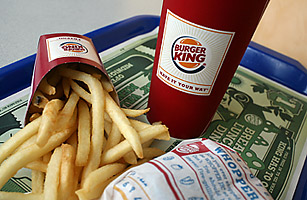
Fast food chains are notoriously cagey about telling consumers how their food gets from the field to the feedlot to the drive-thru window. Hope Jahren, a researcher at the University of Hawaii, believes consumers have a right to know how their food is made. She is the co-author of a new study that sampled almost 500 fast food items from McDonald’s, Wendy’s and Burger King and proved what many Americans may already suspect: On a chemical level, the vast majority of fast food meat derives from a single source: corn. She did this by following the vegetable’s unique chemical markers that persist even after it’s been processed and mixed with other ingredients or eaten as cattle feed. Fast food critics say a single-source, corn-based diet is unsustainable, because the commodity is is heavily subsidized by the government and requires large amounts of fertilizer, water and fuel. TIME talked Jahren about why fast food represents the American diet, what we have in common with Germans and why fast food restaurants are depressing.
Why did you do this study? Was there a non-science motivation?
Half the restaurants in this country are fast food restaurants and they do a hundred billion dollars worth of business a year. For less than $3, you can get a full day’s supply of calories. If you go into one of those restaurants, you will see a constant stream of people all day long. This isn’t a study about fast food. It’s a study about a big portion of the American diet. I’d be glad to walk into many, many dinner times in many, many cities and sample everybody’s plate, but this was a pretty good way of doing just that.
How did you do the study?
We looked at six different cities across the U.S. — San Francisco, L.A., Denver, Detroit, Boston, Baltimore. We studied hundreds of burgers, chicken sandwiches and fries and at several locations in each city. We’ve got a truly national picture of this food.
Is corn-based fast food unique to America?
U.S. meat consumption is the highest in the world. It’s one and a half times higher than the next country on the list, which is Germany. There’s so much meat consumption going on in this country and that’s another reason meat is worth questioning.
In the study, you say you sampled more than 480 servings of fast food. Did you have research assistants at the drive-thru non-stop?
These are people that work in my lab, professional scientists and students in cities where they happened to be, driving around to the restaurants, standing in line getting the food.
What did you find out about the health of the livestock and the health of people eating the food?
The take-home message is that there’s a real information gap for the consumer. Diet-related diseases are on the rise. If you’re suffering from them, your doctor is going to tell you that you’ve got to make informed decisions about what you eat. If you go and try to get this information in order to make these decisions, it’s pretty much impossible. You’ve got to wonder why you have to do nuclear chemistry to get a very simple answer on how your food is made.
Why did you decide to study corn specifically?
Corn is conspicuously subsizied by the government and it has been criticized as being particularly unsustainable with respect to its requirements for fertilizer and irrigation and the machinery required. Corn is worth examining.
One striking fact in your study is that fast food restaurants get their meat from such a small number of suppliers. You say that all three of these chains get all their chicken from Tyson. There’s certainly a lot of Tyson chicken in the grocery story too.
Exactly. Every piece of chicken I’ve ever seen could be Tyson chicken. How would I know?
Do you eat fast food?
No, I don’t. That was one of the rules of the study — that you may not eat anything you buy for the study. But that’s just scientific protocol. You have to be professional.
But as a rule, you don’t eat fast food?
The last time I did was like 2004, long before I did this work. If you go and sit in one of these restaurants for several hours or if you visit a lot of them, there’s just kind of a real aura of misery and unhappiness — both in the place and the folks coming in and out. It’s striking compared to other restaurants. I think that’s what influenced me more than anything.
See 9 kid foods to avoid.
Read “Hooked on McDonald’s at Age 3”.